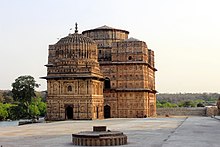| This article needs additional citations for verification. Please help improve this article by adding citations to reliable sources. Unsourced material may be challenged and removed. Find sources: "Vir Singh Deo" – news · newspapers · books · scholar · JSTOR (January 2015) (Learn how and when to remove this message) |
| Raja Vir Singh Ju Deo | |
|---|---|
| Raja of Orchha | |
 | |
| Reign | 1605-1626/7 |
| Predecessor | Ram Shah |
| Successor | Jhujhar Singh |
| Spouse | Parmarji Amrit Kunwari of Shahbad
Parmarji Guman Kunwari of Khairuwar Parmarji Pancham Kunwari of Shahbad |
| Issue | Jhujhar Singh
Pahad Singh Narhar Das Tulsi Das Beni Das Hardev (Hardaul) Bhagwan Rao Chandra Bhan Kishan Singh Bagh Raj Madho Singh Parmanand Kunj Kunwari |
| House | Bundela Rajput |
| Father | Madhukar Shah |
| Mother | Parmarji Ganesh Kunwariji |
| Religion | Hinduism |
Raja Vir Singh Ju Deo, also known as Bir Singh Dev, was a Bundela Rajput chief and the ruler of the kingdom of Orchha in the historic Bundelkhand region of modern Madhya Pradesh. He was a vassal of the imperial Mughal Empire. and ruled between the year 1605 and either 1626 or 1627.
Vir Singh Deo assassinated the Mughal chronicler and court historian Abul Fazl who was returning from Deccan in a plot contrived by the Mughal Prince Salim later Jahangir. He is also credited to have built the Jhansi Fort.


Deo was among the Rajput rulers of his era who sponsored temples in the Brajmandal area that comprised Vrindavan and Mathura. In addition, the Phool Bagh gardens, and the Lakshmi temple were all built by Deo. His mausoleum is located in Orchha, and features both Hindu and Mughal architecture.
Vir Singh Deo was succeeded by Jhujhar Singh, the first-born son of the senior of his three queens.
Deo was patron to the poet Keshavdas, who wrote the 1607 hagiographic work Virsimdevcarit (Deeds of Vir Singh Deo).
References
- Mehta, Jaswant Lal (2005). Advanced Study in the History of Modern India 1707-1813. Sterling Publishers. p. 105. ISBN 978-1-93270-554-6.
- Michael, Thomas (2009). Cuhaj, George S. (ed.). Standard Catalog of World Coins, 1801-1900 (6th ed.). Krause Publications. p. 728. ISBN 978-1-44022-801-8.
- "Fort and Palace at Orchha". British Library. Retrieved 26 March 2015.
- Aruna (2002). Orchha Paintings. Sharada Pub. House. p. 6. ISBN 978-8-18561-669-8.
- Busch, Allison (2011). Poetry of Kings: The Classical Hindi Literature of Mughal India. Oxford University Press. p. 7. ISBN 978-0-19976-592-8.
- Jain, Ravindra K. (2002). Between History and Legend: Status and Power in Bundelkhand. Orient Blackswan. p. 84. ISBN 978-8-12502-194-0.
- Busch, Allison (2011). Poetry of Kings: The Classical Hindi Literature of Mughal India. Oxford University Press. pp. 45–46. ISBN 978-0-19976-592-8.
This biography of a member of an Indian royal house is a stub. You can help Misplaced Pages by expanding it. |